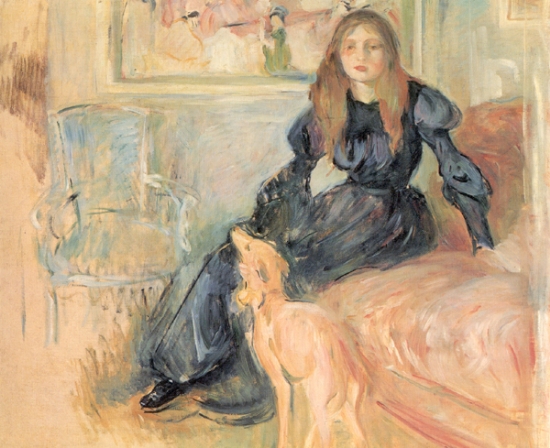Julie Manet was born in Paris in 1878. She was the only daughter of the Impressionist painter Berthe Morisot and her husband Eugène Manet, the younger brother of the painter Édouard Manet. She is famous because throughout her life she posed as model for her mother and uncle as well as for other Impressionists painters.

(Photo credit: Wikiart)
Within a period of three years she lost both parents, being orphaned at the age of 16, when she came under the guardianship of Stéphane Mallarmé, who was a very close friend of her mother, and went to live with her cousins. He also received support from other friends of her parents, Renoir in particular.
Her diary
The Journal of Julie, which was published in English as Growing up with the Impressionists, was written between 1893 and 1899. In it, Julie wrote about art, painting, her readings, and also about the trips she made with her mother. Morisot devoted herself to the education of her daughter, since Julie not only painted and drew, she also played the violin, visited museums and other places of cultural interest and read the books of consecrated writers. In the diary Julie also mentioned that when travelling, she and her mother always dedicated some hours of the day to the painting and that they liked to take long walks.
We also notice in the book a constant concern of Julie to do always the right thing, to give the best of herself, to be gentle and grateful with her friends and family… as she wanted to make her parents proud of her, wherever they were.

Other aspect of Julie’s personality that is very obvious in the book was her religiosity. She was a devout Christian and I think that she found in religion a refugee, especially after the loss of her mother, finding in the church the comfort a 16-year-old orphan needed.
For me, the most interesting aspect of this book is her artist perspective, as in every moment (especially in the descriptions of monuments, places, artworks) she shows the world around her through the gaze of a painter. It is true that today we do not know any of her paintings, we know that she painted and drew, but we never saw any of her paintings. Probably because she was never as good as her mother or uncle. And to be honest I would love to see something painted by her.

(Photo credit: Wikiart)
In the book she always mentions her work with a great self-criticism, never being completely satisfied with the result. She always demonstrated humility not only to accept the comments of those who tried to guide her in the world of painting, as Renoir did, but she really wished to know their opinion, to know what they truly thought about her work and how could it be improved.
Other reasons to read the book:
- If you are an Impressionism lover, you must read. Julie offers the thoughts and daily life details of Morisot, Renoir, Monet, Degas or Sisley.
- She wrote about the visit of the Tsar Nicholas II in 1896 and also about the Dreyfus Affair. It was a political scandal that divided the country, and based on her candid accounts of dinner-table conversations it is possible to see private opinions of Renoir, Degas and Mallarmé.

(Photo credit: Wikipedia)
Curiosity:
Julie married Ernest Rouart, who was artist and nephew of the painter Henri Rouart in May 1900, it was a double ceremony in which her cousin Jeannie Gobillard married Paul Valéry. The wedding ceremony took place in Passy.
References:
- Manet, Julie. 2017. Journal 1893-1899. Le temps retrouvé. Mercure de France. (Here a link to its version in English)
- Wikiart
- Wikipedia









You must be logged in to post a comment.